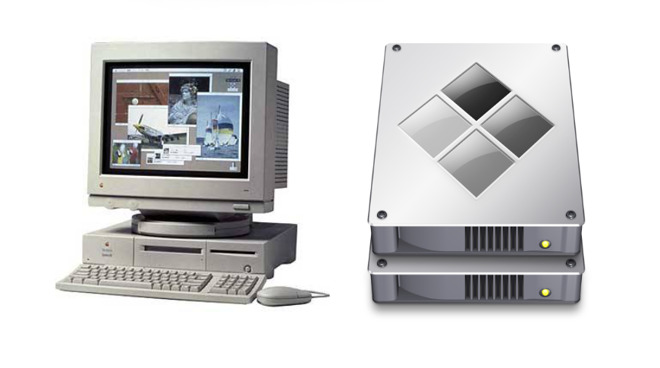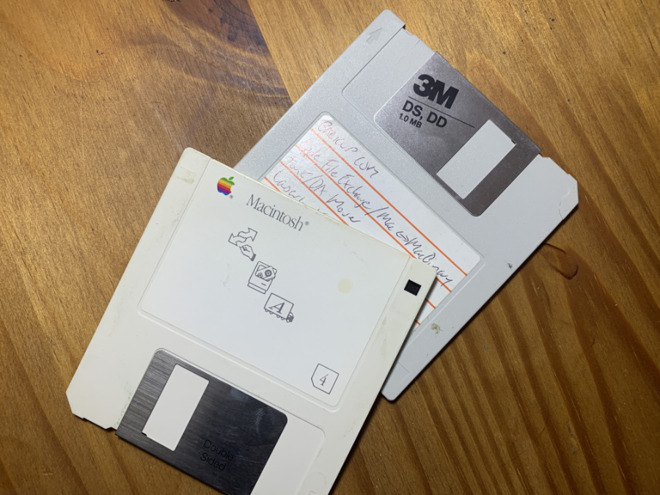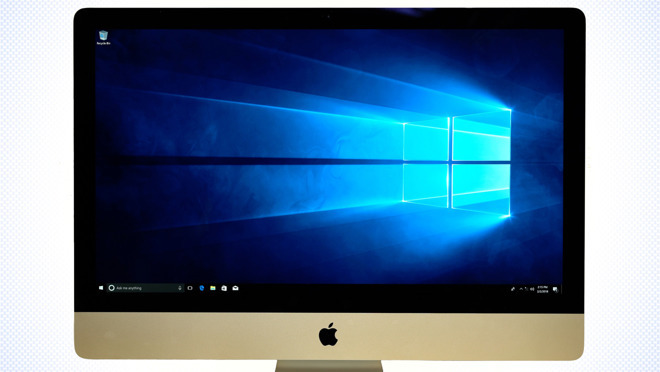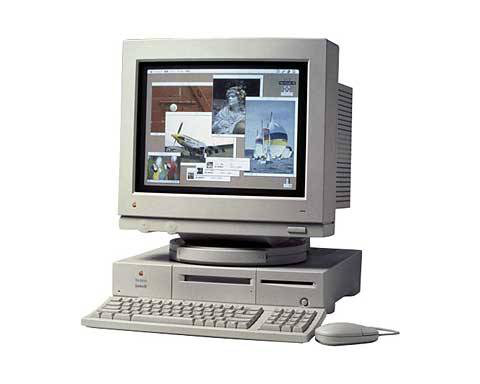Editorial: Apple's move to ARM is possible because most users want power more than compati...
What was once at least a concern and often the barrier that stopped Mac sales, cross-platform software compatibility is now mostly irrelevant to the wider user base -- and we all stand to benefit.

From the DOS Compatible Mac (left) to Boot Camp
Twenty-five years ago, I was features editor on PC Direct and had a monthly column in Macworld UK about working with both Macs and PCs. It was about how to read PC floppies, how to work with people when you're on the Mac and they're on Windows. Hand on heart, it's difficult to remember now what it was about because it's a quarter of a century ago and none of it is needed anymore.
This week, Jason Snell of the US Macworld argued that Apple had once needed to be compatible with PCs and other industry standards, but it isn't any more and it doesn't have to be. To check the numbers, an AppleInsider poll asked readers a similar question about whether they used Bootcamp or any way of running Windows on their Mac.
Of the 782 responses to that on Twitter, 65% said no, they only needed Macs to be Macs. That does leave 35% who do need Windows compatibility, and they had many good points such as needing the Excel macros that aren't available in the Mac version of that app.
However, that is 35% of AppleInsider readers and followers who responded. AppleInsider readers as a whole have long experience and familiarity with the Mac and you can presume that they push the machines to the limit. And you can be certain that the majority of Mac users today do not do that.
It's also gone from incompatibility meaning that Macs used proprietary ports and connectors to now, when Apple either follows standards or is how certain ones like Thunderbolt become mainstream.
Whenever you bought a Mac, you always bought it because you needed what it could do. Today, given the evolution of the web and cloud services, most needs don't automatically include worrying about what platform a client of yours is using. And, if Apple has actually got us to this stage through successive deliberate moves such as the forthcoming move to only allowing 64-bit apps, it feels as if we've got here by stealth.
I did leave computer journalism for drama, and then back again, but I never left the Mac. Until today there was no one moment when I really realized how big a change Apple was going through. I obviously did notice when I lost the Macworld UK commission, but I didn't notice when I stopped being mailed PC floppies or had to use Apple File Exchange to open documents.

William Gallagher working on a PC magazine and writing about Macs in 1993. I still have the hair. You're never going to check.
There's no question that, as Snell says, Apple needed to drop its proprietary hardware over a decade ago. But, as well as making the Mac more compatible, that move also freed up Apple. Instead of reinventing everything and creating new prayers for the SCSI terminator gods, Apple could buy more widely used components and concentrate on making everything else.
That included dropping components as well as creating them. Even as it was struggling to climb back up into being relevant, the Mac still shed devices like the CD drive. Apple did not just cave in and make a PC with Mac OS 9 on it.
Then there is also no question that the internet helped get Apple out of its dependency on compatibility. When someone can email you a Word document, you don't need a floppy drive that can read PC disks. When you're filling out a form on the web, no decently coded site should care what machine you're typing on.
However, it has also got to be the case that the iPhone has played a part here.
On the whole though, we had a long patch where you bought a Mac or you bought a PC -- and in truth, most people bought a PC.
No matter how good the Mac was, it wasn't able to get people to switch from PCs in significant numbers. Yet then came the iPhone, and that was so extraordinarily good that it became peculiar to buy anything else. And then the iPad came, and dominated the tablet market that Microsoft had been trying to pin down for a decade.
The arrival of Android has changed all of this somewhat, but with the iPhone and the iPad, was still the case that some people were seeing Apple's computing work for the first time and they were liking it very, very much.
The iPhone came out in 2007 and shortly before it, Apple moved the Mac from PowerPC to Intel. That was a difficult technical and business challenge that the company pulled off so well that we barely noticed it and we don't remember what it was like.
Adobe was slow to move its apps to run on Intel on the Mac, for instance, because it knew it could be because Apple wasn't a priority then. "Although Mac OS X has been shipping almost for ten years now, Adobe just adopted it fully two weeks ago when they shipped CS5," wrote Steve Jobs in 2010. "Adobe was the last major third party developer to fully adopt Mac OS X."

You may not be able to read my handwriting, but that's "Apple File Exchange," amongst others, on the top disc.
Jobs wrote that in his famous memo about Flash on the iPhone. Adobe thought it could force Apple to use Flash on the iPhone and wrote Steve Jobs in 2010. Microsoft complained too.
They were both wrong and today we have Microsoft making its best-ever Word and Excel for the iPad. They could still kill a few more bugs in the Mac version, but they're working with Apple and Adobe is currently bringing Photoshop to the iPad.
Apple is no longer the other platform, the one you mop up after you've done Windows.

You can run Windows 10 on your Mac... it's not just clear now why you'd want to
Only, I deliberately said Apple there, not Mac. It is the combination of the Mac and iOS, it is the Apple ecosystem, that is appealing to users and in sufficient volume that it's therefore appealing to developers.
It's the same for Apple as it always has been for people looking for work or even romance. It's when you don't need someone that you're suddenly attractive. Apple doesn't need anyone at all, and right now that's got us a rich environment where enjoying the Mac's superior operating system does not require thought or compromise.
It's what happens next that's going to be interesting.
When the first ARM Mac comes out, few buyers in the target market are going to notice because few will need to. Apple is sufficiently distinct from PCs that if anyone really wants Windows, they'll stay on a PC. And Apple is sufficiently powerful now that there will not be another delay for the likes of Adobe.
You can make that case solely on how independent the Mac platform is now, but then there is more. Project Catalyst is going to bring iOS apps to the Mac and if there is anywhere that Apple is beholden to no one, it's with the iPhone and iPad App Store.
In the end, Apple will do what it has always done and make the devices that will sell. It's just that today, Apple is a juggernaut that can decide its own fate and not bother with any compatibility that it doesn't want to.
Keep up with AppleInsider by downloading the AppleInsider app for iOS, and follow us on YouTube, Twitter @appleinsider and Facebook for live, late-breaking coverage. You can also check out our official Instagram account for exclusive photos.

From the DOS Compatible Mac (left) to Boot Camp
Twenty-five years ago, I was features editor on PC Direct and had a monthly column in Macworld UK about working with both Macs and PCs. It was about how to read PC floppies, how to work with people when you're on the Mac and they're on Windows. Hand on heart, it's difficult to remember now what it was about because it's a quarter of a century ago and none of it is needed anymore.
This week, Jason Snell of the US Macworld argued that Apple had once needed to be compatible with PCs and other industry standards, but it isn't any more and it doesn't have to be. To check the numbers, an AppleInsider poll asked readers a similar question about whether they used Bootcamp or any way of running Windows on their Mac.
Of the 782 responses to that on Twitter, 65% said no, they only needed Macs to be Macs. That does leave 35% who do need Windows compatibility, and they had many good points such as needing the Excel macros that aren't available in the Mac version of that app.
However, that is 35% of AppleInsider readers and followers who responded. AppleInsider readers as a whole have long experience and familiarity with the Mac and you can presume that they push the machines to the limit. And you can be certain that the majority of Mac users today do not do that.
The majority don't need Windows
So for them, for Apple's biggest user base, the need for Windows compatibility isn't the same as it is for the main readers of this site. This need for Windows compatibility has gone from when there was enough interest and plenty enough to say that I had many months employment, to now when Windows and Boot Camp is a tool for specialist users like AppleInsider readers.It's also gone from incompatibility meaning that Macs used proprietary ports and connectors to now, when Apple either follows standards or is how certain ones like Thunderbolt become mainstream.
Whenever you bought a Mac, you always bought it because you needed what it could do. Today, given the evolution of the web and cloud services, most needs don't automatically include worrying about what platform a client of yours is using. And, if Apple has actually got us to this stage through successive deliberate moves such as the forthcoming move to only allowing 64-bit apps, it feels as if we've got here by stealth.
I did leave computer journalism for drama, and then back again, but I never left the Mac. Until today there was no one moment when I really realized how big a change Apple was going through. I obviously did notice when I lost the Macworld UK commission, but I didn't notice when I stopped being mailed PC floppies or had to use Apple File Exchange to open documents.

William Gallagher working on a PC magazine and writing about Macs in 1993. I still have the hair. You're never going to check.
There's no question that, as Snell says, Apple needed to drop its proprietary hardware over a decade ago. But, as well as making the Mac more compatible, that move also freed up Apple. Instead of reinventing everything and creating new prayers for the SCSI terminator gods, Apple could buy more widely used components and concentrate on making everything else.
That included dropping components as well as creating them. Even as it was struggling to climb back up into being relevant, the Mac still shed devices like the CD drive. Apple did not just cave in and make a PC with Mac OS 9 on it.
Then there is also no question that the internet helped get Apple out of its dependency on compatibility. When someone can email you a Word document, you don't need a floppy drive that can read PC disks. When you're filling out a form on the web, no decently coded site should care what machine you're typing on.
However, it has also got to be the case that the iPhone has played a part here.
No standards
Back before my '90s computer journalism days, there were the years where every company brought out incompatible machines and then there were ones where they didn't. There might have been the odd attempt to break the Mac/PC stranglehold, and that may have included good machines like the Amiga.On the whole though, we had a long patch where you bought a Mac or you bought a PC -- and in truth, most people bought a PC.
No matter how good the Mac was, it wasn't able to get people to switch from PCs in significant numbers. Yet then came the iPhone, and that was so extraordinarily good that it became peculiar to buy anything else. And then the iPad came, and dominated the tablet market that Microsoft had been trying to pin down for a decade.
The arrival of Android has changed all of this somewhat, but with the iPhone and the iPad, was still the case that some people were seeing Apple's computing work for the first time and they were liking it very, very much.
The iPhone came out in 2007 and shortly before it, Apple moved the Mac from PowerPC to Intel. That was a difficult technical and business challenge that the company pulled off so well that we barely noticed it and we don't remember what it was like.
Adobe was slow to move its apps to run on Intel on the Mac, for instance, because it knew it could be because Apple wasn't a priority then. "Although Mac OS X has been shipping almost for ten years now, Adobe just adopted it fully two weeks ago when they shipped CS5," wrote Steve Jobs in 2010. "Adobe was the last major third party developer to fully adopt Mac OS X."

You may not be able to read my handwriting, but that's "Apple File Exchange," amongst others, on the top disc.
Jobs wrote that in his famous memo about Flash on the iPhone. Adobe thought it could force Apple to use Flash on the iPhone and wrote Steve Jobs in 2010. Microsoft complained too.
They were both wrong and today we have Microsoft making its best-ever Word and Excel for the iPad. They could still kill a few more bugs in the Mac version, but they're working with Apple and Adobe is currently bringing Photoshop to the iPad.
Apple is no longer the other platform, the one you mop up after you've done Windows.

You can run Windows 10 on your Mac... it's not just clear now why you'd want to
Only, I deliberately said Apple there, not Mac. It is the combination of the Mac and iOS, it is the Apple ecosystem, that is appealing to users and in sufficient volume that it's therefore appealing to developers.
It's the same for Apple as it always has been for people looking for work or even romance. It's when you don't need someone that you're suddenly attractive. Apple doesn't need anyone at all, and right now that's got us a rich environment where enjoying the Mac's superior operating system does not require thought or compromise.
It's what happens next that's going to be interesting.
Money where your mouth is
In all likelihood, Apple is going to move away from Intel to using ARM processors in the Mac. You can expect that it will start soon with the MacBook, and you can bet that it won't happen with the Mac Pro for many years, if at all.When the first ARM Mac comes out, few buyers in the target market are going to notice because few will need to. Apple is sufficiently distinct from PCs that if anyone really wants Windows, they'll stay on a PC. And Apple is sufficiently powerful now that there will not be another delay for the likes of Adobe.
You can make that case solely on how independent the Mac platform is now, but then there is more. Project Catalyst is going to bring iOS apps to the Mac and if there is anywhere that Apple is beholden to no one, it's with the iPhone and iPad App Store.
In the end, Apple will do what it has always done and make the devices that will sell. It's just that today, Apple is a juggernaut that can decide its own fate and not bother with any compatibility that it doesn't want to.
Keep up with AppleInsider by downloading the AppleInsider app for iOS, and follow us on YouTube, Twitter @appleinsider and Facebook for live, late-breaking coverage. You can also check out our official Instagram account for exclusive photos.




Comments
2. Mac Pro shows Pros Need and Wants the Mac, and I doubt Apple will design a CPU working at 250W just for the Mac Pro Market.
3. The Mac in the long run will be Pro only. Whether that is Prosumer or Professionals, iPad with iPadOS is where the consumers will goes to. ( At least that is the direction Apple hopes to happen )
1.) QUALITY
2.) Power
firstly, no, the ‘a serir]es still has a long way to go before it can compete with AND and Intel at the higher levels, with no guarantee that it ever will. That’s all speculation. Are we going to see a 6 core chip? An 8 core chip? These will be needed to compete on the higher laptop level. 16GB RAM? 64GB RAM? Same thing.
convincing developers, particularly those with very large, high performance software to go native ARM? And, yes, that will be needed.
if Apple does begin this process, it will be a very difficult one.
iPad OS + iPad Pro combo is a more advanced concept than MacARM. The future is the iPad. Macs will continue to exist but for backwards compatibility and for industrial legacy applications only. And if Intel does well within this limited role, it will always do.
2) We know that Apple's chip designs can compete because we already have evidence that their chips are outpacing what they're putting into many of their Macs, but you're incorrectly assuming that they only way Apple could come out with an ARM-based Macs on the lower-end (where compatibility for Bootcamp and virtualization won't have to be supported) is for Apple to also best Intel on their upcoming Mac Pro performance.
Of course Apple has begun this process. Do you really not see all these changes to their codebase at WWDC as not leading to this eventual transition to offer some ARM-baed Macs?
Do you see companies like Adobe, Avid, Autodesk, Microsoft, Unity etc. embracing this? If someone can’t use Pro Tools or AutoCad on the Mac because it’s not ARM compatible I can’t see it being successful. So maybe the pro Mac line stays Intel. I’m still curious to see what Apple does with the 12” MacBook. Has it not been updated because of Intel or is Apple saving it as an ARM Mac test case? I think it would be the perfect product to start with.
What they lack is offerings in the lower end of the market. When Apple took over the music player market, they started off at the higher end and worked their way down. The shuffle essentially killed off the competition.
If Apple do introduce an ARM Mac I hope it is at the low end because Apple already take 90% of the profit from the mid to high range of the market. If they can offer an entry level Mac laptop in the $700-$900 range it will push the competitors to lower cost product range. Sure you will still get PCs at all price ranges but the profits will be good because they will have to reduce their margins to compete.
We all should expect that Apple have been running an ARM version of MacOS for a while now. Plus have units in development in their skunk works. When (or if) they pull the trigger is another question. My major fear is that Apple is try to sell an ARM Mac at a premium and it does not break of out being just a niche player.
Bringing Mac apps to iOS on ARM is not gonna happen. Going CISC to RISC is full of roadblocks. I won't list them as they've been covered to death in the past.
2) This is article isn’t about Mac apps going to iOS, it’s about the obvious progression to make macOS run on ARM. ARM does not equate to iOS.
I’ve recently been shopping around for a college laptop (niece). I narrowed it down to 2 machines but was forced to throw out the Air model. The specs/hardware aren’t worth considering.
2 models
MacBook Pro 13 Core i5 8GB/256GB ($1500-1600)
Samsung Notebook Pro 9 2 in 1 Core i7 8GB/256GB ($1000) includes a stylus
Budget reported by parent $1000 (big problem #1)
Niece requested a MacBook (big problem #2)
Basically, the Samsung is 1/3 less and a better machine but is hobbled by Windows 10. The Samsung and Apple both have “premium” hardware. I agree that Apple has issues competing, they try to use old models/hardware but just come off as overpriced.
I’m also looking forward to a ARM based MacBook, but performance might be a bigger headache than straight speed tests suggest. Qualcomm and Microsoft have put considerable effort into their ARM offering, but performance has been terrible. Apple has done a lot of tinkering to optimize ARM and iOS and performance is impressive, but it also isn’t designed to multitask (they do have clever workarounds). A ARM processor in a MacBook is going need to excel at multitasking. This might be a much bigger problem/challenge than Apple fans are thinking, it might be a fundamental limitation of ARM that throwing additional cores/memory at the problem doesn’t fix. We’ll see...
1) Android software
2) Enterprise software (with java, x86 Linux and Windows servers with x86 databases like Oracle and MS SQL Server).
This is possible thanks to virtualization technologies like Parallels, VirtualBox, Docker and cross-platform development environments.
I use Docker virtualization with Linux x86 container and within it Oracle database - I don't see way to migrate with OS/X to non Intel CPU with this software stack. It is 3 levels deep dependency on x86.
Generally, ARM based Mac would be almost use-less for backend programming (depending on project and used technologies of course).